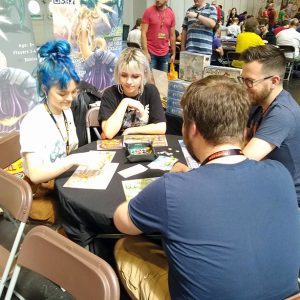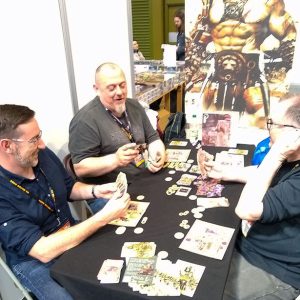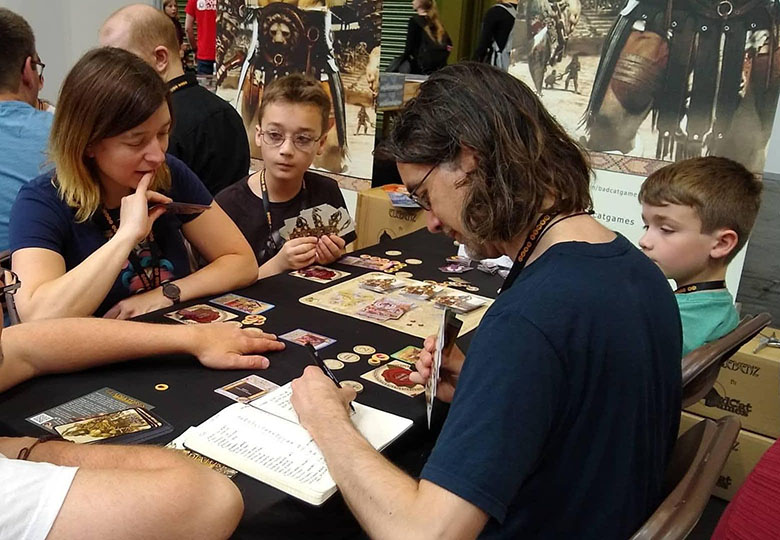This year was our 3rd UKGamesExpo at Birmingham NEC and the best by far. Every year the BadCatGames stand grows (but perhaps not proportionally) as the event itself grows. This year unconfirmed reports put Expo 2018 as the 3rd or 4th largest show in the world, behind Essen, Cannes and GenCon with 21k+ individuals attending. Hall 1 is almost stretching at the seams now and we love the use of the second section up the stairs – not just for the photo ops!
The elusive designer Jason was there along with 2/3rds of the BadCat team (Chris and Cheryl) supported by our demoers Giles and Rob and some of the younger BadCatTribe (Laureline, Anna and Elliot) who did a sterling job converting dice game fans into fans and buyers of Elemenz. For some of the younger team it was their first gamecon and they had a blast by all accounts; even making friends with rivals – looking at you ITB team! (only kidding) + they got to sneak in a few quick games before the con started (yes we have the tribe signed up already for a repeat next year !). It was lovely to get compliments from gamers about how enthusiastic, competent and dedicated our demo team was, especially Elliot who managed to sell a copy of Elemenz to everyone sitting around the table at one point!
Our 10sqm plot at UKGamesExpo was still not enough space to handle the numbers of eager gamers keen on trying their chances on the arena sand in Gladiatores: Blood for Roses or summoning their energy dice to do battle in Elemenz. Our location down from the main entrance seems to have a lot better footfall as we are close to the Esdevium gaming area and our stand is a natural corner point for folk to change direction and head into the twisty confusing labyrinthine alleyways of central Hall 1!

The new location is also ideal to set up and dismantle (yes we have dibs on it for future years so back off exhibitors) as we are close to one of the rear exit doors, so it’s just a quick upload/ offload to get all our gear moved from transport to con. Also because of the corner position and close to the Esdevium stand we felt there was much more room for gamers to hang around and see what was going on (pausing for drink or scrutinising the increasingly complex Hall1 map).
Expo is definitely getting better every year and hats off to the organisers (Richard Denning and team) for the huge effort they make each year to create an all inclusive 3 days of gaming extravaganza. UKGamesExpo should indeed lock itself into the top 3 position from now on.
We really enjoyed chatting to all the excited gamers and an array of cosplayers throughout the 3 day UKGE event. This kept us busy and in the end we didn’t get to record the podcasts, live feeds from our demo tables and videos we would have loved to have shared online. We spent a lot of quality time just talking with folk; backers, industry professionals and reviewers who stopped by to talk about our games.

BadCatTribe Demoing Elemenz

Everything kicks off in the arena
Gladiatores seemed to be a hit with everyone, from families to septuagenerians, to those just looking to spill the blood of their gladiator opponents on the sands of the colosseum. For a change the BatCatTribe actually did well and survived a few bouts, impressing the crowds. A lot of this has to do with knowing the hidden tactics of card combos or matching certain cards with the unique abilities of the Gladiators. The gamers who tried the game (young or old) got the hang of it quickly and we estimated that even as a completely new player – a single fight lasted only about 15mins/player – which is our normal time estimate and pretty reasonable for a card game designed to be quick and intense ! Some great ideas came out of these sessions, with great suggestions on how players would like to see an element of overarching campaign and progression. Watch this space folks !

Gladiatores maybe a combat game but is family friendly
UKGamesExpo 2018 was again a complete blast for the team and we want to give a huge thanks to all the gamers who came by to say hi, chat with us and try out one of our games. We meet new faces each year and make more and more friends who we get to see at each expo. For us, that is what makes UKGE special and therefore consider yourselves all as honorary members of the BadCat Tribe. Now we have settled in to the site in Hall 1, we have big plans for how to kit out our stand in the future for the retail launch of Gladiatores: Blood for Roses. See you there in 2019 !
Our Top 5 games# by Thomas Lehmann; Published by Rio Grande Games 2007
A very slick card game that is steeped in theme, has a huge number of variable tactical options that makes each time played a unique and varied experience. The game is a masterclass in converting rules to icons (although initially its easy to panic at the level of confusion raised by the plethora of symbols arranged over each card) and after a play or two, most players have got the hang of the game flow and settle down. Secondly, the mechanic of using the cards themselves as resources to be spent during the game is inspired since it almost removes the need for extra tokens. (Note that later expansions start to introduce extra tokens for different functions). Having a limited hand of cards that are all potentially interesting, and then from which resources are drawn or cards are spent to buy others, means that frustrating and difficult decisions have to be made on which to keep and which to ‘burn’ – but at the same time it keeps the stock/deck of cards flowing and new options or possibilities arise at every turn.
# by Richard Launius and Kevin Wilson; Published by Fantasy Flight Games
As gamers (including RPGs and Digital games) we immediately felt at home with Arkham Horror (AH). It seemed to be a storyline RPG in tabletop format and is still one of the best at telling tales as far as we are concerned. AH turned the RPG character sheet concept on its head (just look at where WFRP3e went with that) and did away with the need for a GamesMaster (GM) entirely – meaning everyone could get in on the action (and die screaming together in some kind of inter-dimensional limbo!) With the possibility that all the standard RPG stuff (like equipment lists, traits, special abilities, skills and powers could be kept on small extra cards) could be more or less randomised each game meant no character was really ever the same when played multiple times. Add to this the monster stats, trackable circumstances/events and adjustable traits (by which I mean SANity and Health) being removed from sheets onto tokens meant that the player group could much more easily see what was going on during the game. Storylines are generated through descriptive text being present on location coded event cards drawn by each player when they land at the location. Again, this removes the need for the GM and on almost every occasion played makes for some intriguing story-links that happen randomly as successive cards are drawn. In effect the players are given the framework (on the cards) and their group imagination fills in the blanks to make for a memorable experience. For me personally, this is the art of game design working at its best – providing a system that encourages players to exercise their own imagination and really ‘experience’ what the game is trying achieve. My top trick from AH is the inversely proportional link between stats on the character sheets (must be a better term for this but hey – whatever). For example, using the slider to increase your SPEED stat, reduces your corresponding STEALTH stat. Inspired!
# by Bruno Faidutti; Published by Fantasy Flight Games (and many others)
A testament to how simple games can often make the best games. A pile of standard city districts (only a few of which actually have some special effect/power) and a group of characters (Roles) that do have special powers that affect gameplay – against each other. Take a role, get some coinage or new cards, pay for a city district. Next go. And that’s basically it! Essentially the game is a card buying turnaround with characters that mix up options. Simple, but so effective! The test of a great game is how easily you can explain it to others (especially non-gamers) so they get it. Citadels is a classic example. In 5 minutes you are away and outmaneuvering each other while trying to guess other player’s current roles. Only a few cards in hand means options are somewhat limited but that’s ok cos more will come along and meantime keep an eye on the other players and their plans. All colour coded, costs clearly displayed, nice artwork, roles switch around every turn, sorted! It’s one of those games that we keep coming back to again and again. It’s quick, it’s fun and the banter flies across the table. Note: We do swap in the extra character roles from the Dark City expansion though.
# by Uwe Rosenburg; Published by Z-man Games (and others)
Possibly the best example of how a theme makes a game, Agricola rightly is near the top of the all time games list on Boardgamegeek. Tight, thematically spot on (medieval farmers scrubbing out a living in the dirt) and an extremely varied and flexible gaming experience when the additional card packs are used. In a way, its a frustrating game in that each player has lots of lovely choices that can be made (build that urgently needed feed trough or set up a microbrewery) but never enough time to do it all. Worse, since resources are physical (as coloured discs) and limited, they are always running out meaning your grand plans get delayed time and time again. This in its own right is a great mechanic that might seem odd to begin with (annoying your players?) but in fact it generates plenty of banter and pulls players deep into the workings of the game as they try to out-plan each other and secure what they need when they need it even while they can hear the game clock ticking away. There is no downtime – if you play right, you should be constantly planning your next few moves. Its a testament to a great game that non-gamers request it often and when the final round is over – everyone wishes it could carry on for just that little bit longer!! So, the lesson from this one is, its ok to frustrate your players as long as you can draw them in and give multiple alternatives to keep them involved.
# by Antoine Bauza; Published by Asmodee
A relatively new game on the list for us, but one that clearly pushes the right buttons for many variably experienced players (it is the most played game we own at BCG). Essentially a card swapping, resource gathering card game but with a unique and engaging theme that lends itself to gentle rivalry between players, as each tries to build the best Wonder of the World and secure victory points through careful card selection. Again as in Agricola, the frustrating element of ‘wanting to do more’ each game is there as the ‘Select 1 card, Pass the rest’ card shuffle mechanic means each turn a player has to give away potentially good cards that may not return. For us again, having all required information clearly available on the cards (e.g. costs, benefit icons and linking cards) means that very quickly players are in the flow and don’t need to return to the rules. Careful use of iconography explains the variable abilities of cards and are clear enough that other players can help when a player is confused (e.g. for resource purchases from neighbours). The exception to this is the somewhat confusing Science options for scoring but the rules clearly layout examples. Having varied Wonders that can be chosen from each play means the game stays fresh for longer and multiple ways to score VPs means players are not often vying for the same VP sources. Thus there never seems to be a runaway winner and final scores are always a surprise.
You must be logged in to post a comment.